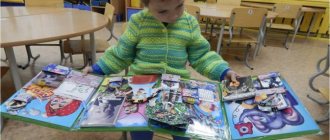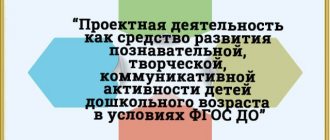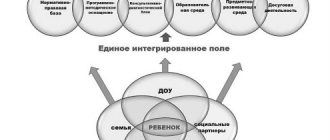Correctional and developmental work in preschool educational institutions
CORRECTIONAL AND DEVELOPMENTAL WORK IN PRESIDENTIAL EDUCATIONAL INSTITUTIONS
At the present stage, the concept of integrated training and education is the leading direction in the development of special education in our country. This means the equal inclusion of a person developing in conditions of insufficiency (mental, physical, intellectual) into all possible and necessary spheres of social life, a decent social status and self-realization in society.
The spread in our country of the process of integration and inclusion of children with disabilities (CHD) mental or physical health in educational institutions is not only a reflection of the times, but also represents the realization of children’s rights to education in accordance with the “Law on Education” of the Russian Federation. Inclusive education ensures equal access to one or another type of education and creates the necessary conditions for all children to achieve success in education.
The group of children with disabilities includes children whose health condition prevents them from mastering all or some sections of the educational program of a preschool institution outside of special conditions of education and training. The group of preschoolers with disabilities is not homogeneous; it includes children with various developmental disorders, the severity of which may vary.
Currently, in accordance with modern research in special psychology and correctional pedagogy, the entire contingent of preschoolers with disabilities in our institution can be divided into three groups, which makes it possible to determine the goals of correctional work in each of these groups and the areas of activity of the teaching staff that correspond to the educational needs of children (table 1).
Table 1
| Options | Groups of pupils with disabilities in preschool educational institutions | ||
| Categories of pupils with disabilities | I | II | III |
| Frequently ill people and those with chronic somatic diseases (health group) | 1. Socially and pedagogically neglected children. 2. Children with mental retardation of psychogenic origin. Main restrictions: -underdevelopment of mental processes and personality traits; - lag in the development of the leading type of activity; -low level of development of productive activity of preschool children; -narrow outlook, unformed communication skills | Children with disabilities who have a diagnosis established (PMPC) and prescribed in a certificate of the established form: - with speech impairments; - with mental retardation | |
| Special educational needs of children with disabilities | — special group for private security; — health-saving technologies of education; — taking into account the implementation of the student’s mastery of the basic educational program; — individually selected mode of training and education | -special correctional group for children with disabilities of type VII; -development of cognitive mental processes and personality traits to the level of the age norm; -expansion of general horizons; -additional educational classes for mastering OOP; health-saving technologies; -individually selected route of training and education | Educational needs correspond to the characteristics of developmental disorders: — special correctional group for children with speech disorders of type V; -special correctional group for children with disabilities of the VIII type; -development of cognitive mental processes and personality traits; -expansion of general horizons; -individual additional classes; -health-saving technologies of education; — individually selected training and education route |
| Goals of correctional work | - health promotion; - assistance in mastering OOP | -correction of developmental deficiencies; - assistance in mastering APP; -health promotion | -correction of developmental deficiencies; -assistance in mastering general education and special educational programs; -health promotion |
| Directions of correctional work | -creation of a health-saving educational environment; - overcoming difficulties in mastering acute physical education | -creation of a developing space; -development of leading and productive activities; -psychological development; -speech therapy assistance; - pedagogical correction of developmental disorders; — creation of a health-saving educational environment. | In accordance with the structure of the defect or the level of developmental disorder: — creation of a developing space; -psychological development; -speech therapy assistance; - pedagogical correction of developmental disorders; — creation of a health-saving educational environment. |
| Forms, methods and means of work | Special program for CHBD “Healthy Baby” | Model program “Preparation for school of children with mental retardation / Under the general editorship. ; -involvement in interaction with peers; -psychological and pedagogical support; -correctional - developmental classes; -speech therapy classes; -physical education and health activities | Typical programs: -program “Overcoming general speech underdevelopment in preschool children with general speech underdevelopment”, . - a program of compensatory preschool educational institutions for children with intellectual disabilities. Correctional and developmental training and education/, -involvement in communication with normally developing peers; -psychological and pedagogical support; -correctional - developmental classes; -speech therapy classes; -physical education and health activities |
| Responsible and executors | -educator; -medical worker | -educator; -teacher – psychologist; -speech therapist, defectologist; -medical worker | - a teacher with professional retraining (“Special pedagogy and psychology”, “Organization and content of speech therapy work”) —teacher – psychologist; -speech therapist, defectologist; -medical worker |
For children with disabilities belonging to category 1 (frequently and for a long time ill, having chronic somatic diseases), preschool educational institutions operate health groups for frequently and long-term ill children of early and preschool age.
The educational process with pupils of these groups is carried out in accordance with the main general education program of the preschool educational institution, and physical education, health and therapeutic and preventive measures are carried out on the basis of the special “Healthy Baby” program.
This program defines the main directions, tasks, as well as the implementation of assigned tasks within one year. The program begins its work from September to August. The diagnosis of NBD is made by the pediatrician who supervises the preschool educational institution for the analysis of morbidity for the entire past calendar year. The whole life of a child in a health group in a preschool educational institution is aimed at preserving and strengthening health. The basis is weekly physical education classes (3 times a week, 1 time in the fresh air), classes with a psychologist, partner joint activities of teachers, parents and children during the day.
Purpose of the program:
Preserving and strengthening the health of frequently ill children, transferring from the group of frequently ill children to the group of occasionally ill children; creation of a health-saving educational environment; overcoming difficulties in mastering the basic general education program (BEC).
For category 2 children with disabilities, in the 2013–2014 school year it is planned to open a specialized group of type 7 for children with mental retardation.
The purpose of correctional speech therapy work in preschool educational institutions
– providing children with speech impairments with the opportunity to master the basic general education program of preschool education and their integration into a general education institution.
Correctional and speech therapy work in kindergarten is carried out by teachers - speech therapists to identify speech defects and its maximum correction on the basis of two speech centers and a special (correctional) group of type V for children with speech disorders.
Based on the conclusion of the district PMPK in the 2010 – 2011 academic year. year, 13 pupils were recommended to undergo training in a special (correctional) program of type V for children with speech disorders.
In the current academic year, in order to create an integral system that provides optimal pedagogical conditions for the timely correction of disorders in the development of children’s speech (of a primary nature), in their mastering of the main general education program of preschool educational institutions, preparing for successful learning for school, a special (correctional) group was opened Type V for children with speech impairments.
Teachers working in a specialized group of a kindergarten have undergone professional retraining in the direction of “Modern technologies for speech therapy examination and correction of speech disorders in preschool children.”
Work with children in a speech therapy group is based on the relationship between preschool specialists:
- teacher - speech therapist;
- group teachers;
- teacher - psychologist;
— medical staff of preschool educational institutions;
— highly specialized specialists (music director, physical education instructor, teachers of additional education in choreography, manual labor, visual arts, ecology).
The educational process with children is built in accordance with the basic general educational program of a preschool institution, taking into account comprehensive thematic planning on lexical topics.
Special correctional and developmental training is carried out by a teacher-speech therapist according to the program “Overcoming general speech underdevelopment in preschool children with general speech underdevelopment.”
The success of correctional and educational work in a speech therapy group is determined by a strict, well-thought-out system, the essence of which is the speech therapy of the entire educational process, the entire life and activity of children.
The only way to implement speech therapy is through close interaction between a speech therapist and a teacher (for different functional tasks and methods of correctional work).
Corrective tasks facing the logogroup teacher:
1.Continuous improvement of articulatory, fine and gross motor skills.
2. Consolidation of the pronunciation of sounds given by the speech therapist.
3. Purposeful activation of practiced vocabulary.
4. Exercises in the correct use of formed grammatical categories.
5.Development of attention, memory, logical thinking in games and exercises using defect-free speech material.
6.Formation of coherent speech.
The main directions of the teacher’s correctional work
1.Articulation gymnastics
(with respiratory and vocal elements) is performed 3 – 5 times during the day.
2.Finger gymnastics
performed in combination with articulation 3 – 5 times a day.
3. Corrective mini-gymnastics
to prevent postural and foot disorders, it is performed daily after a nap.
4.Evening individual lessons
teacher on the instructions of the speech therapist, reinforcing sound pronunciations.
The work is carried out by the teacher using the children’s individual notebooks.
The content of these classes is determined by the program:
- pronouncing syllables, words, sentences using a fixed sound;
- repetition of tongue twisters, short stories, poems;
— exercises in sound-syllable analysis and synthesis;
- repetition of lexical and grammatical exercises;
- exercises to develop attention, memory, thinking.
5. Frontal classes according to the general education program of the preschool educational institution (
and in accordance with the calendar plan of speech therapy work).
6. Corrective work outside of class:
during routine moments, self-service, household work and work in nature, on a walk, excursion, in games and entertainment.
The particular significance of this work is that it provides the opportunity for extensive practice of free speech communication among children and consolidation of speech skills in the everyday life and activities of children.
With the children of the speech therapy group, together with the teacher - speech therapist, educator and teacher of additional education in choreography, educational activities in logorhythmics are carried out directly according to a special program.
Today, teachers and specialists of preschool educational institutions draw up an individual educational route for psychological, medical and pedagogical support of a child with disabilities, which:
— gives an idea of the types of difficulties that a child encounters when mastering the basic general education program;
- reveals the reason underlying the difficulties;
— contains approximate types of activities carried out by the subjects of support, tasks for correction.
It is developed based on the following documents:
— diagnostic chart of difficulties that children encounter when mastering the General Education Program
— cards of psychological and pedagogical support for children, reflecting the most typical difficulties; the reason for the occurrence of this difficulty, a set of tasks for corrective work to overcome difficulties.
Thus, an important component of the successful inclusion of a child with disabilities into the environment of healthy peers is the training of teachers in the integrative process through training programs for advanced training for specialists in early childhood education and programs for improving parental competence.
Get text
What is a correctional kindergarten?
A compensatory (correctional) kindergarten is an educational institution for preschool children with disabilities, which creates conditions for the comprehensive development, treatment and correction of such children. A distinctive feature of compensatory kindergartens is that in addition to educators, special education teachers, relevant medical workers, and child psychologists work with children. The number of children in groups of such kindergartens, as a rule, does not exceed 10-16 people, which makes it possible to devote the necessary attention to each child. Since the number of places in compensatory groups is limited, this has led to the fact that children are forced to stand in line to get a place for quite a long time, and in speech therapy kindergartens and groups there is sometimes overcrowding. The regularity of classes in special groups that bring together children with equal levels of development and similar disabilities allows for targeted and in-depth correction of defects, disciplines children, and gives positive results in preparing for school. At the same time, in practice there are often situations when children with severe mental, behavioral and/or emotional-volitional problems find themselves in a speech therapy group, which creates difficulties in implementing the educational process in the entire group. Almost all correctional kindergartens conduct classes with parents to help them better understand the problems of their child with disabilities and create favorable conditions at home. Admission of children to correctional kindergartens is carried out only with a referral issued on the basis of the conclusion of the psychological, medical and pedagogical commission (PMPC).





